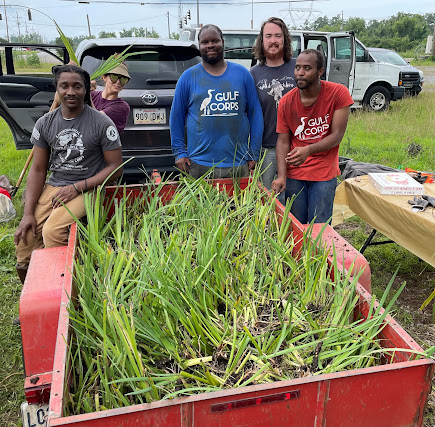By Gary Salathe
My non-profit, the Louisiana Iris Conservation Initiative (LICI), has a Louisiana iris restoration project underway with our partners, the Friends of the Palmetto Island State Park, at the boardwalk in Palmetto Island State Park near Abbeville, Louisiana. One of the project's goals is to increase the number of Louisiana species Iris nelsonii (common name Abbeville Red iris) growing in the swamp at the boardwalk. One critical job that needed to be accomplished was to remove the Chinese tallow invasive tree species from the boardwalk swamp where the irises would be planted.
The Chinese tallow is a drought-tolerant tree native to China and Japan. It was first introduced in South Carolina during the 1700s as an ornamental tree and then for making soap from seed oils. It can be found from eastern North Carolina southward to Florida. From Florida, it spread westerly through Louisiana and Arkansas into Texas.
This August 2023 photo was taken from the Palmetto Island State Park boardwalk in the swamp where the irises will be planted this fall. As seen in the photo, all trees that are 30' tall or smaller are invasive Chinese tallow trees.
Chinese tallow trees can be identified by broad, waxy-green leaves, often with an extended tip or "tail." New growth briefly appears reddish.
In the early 1900s, it was used as an ornamental tree in Louisiana because most of Louisiana's native trees do not produce fall-colored leaves. The Chinese tallow tree does.
The Chinese tallow tree can be easily spotted in Louisiana forests when its leaves change color in late fall. Once this happens, the green color starts to fade from the leaves, and then reds, oranges, and yellows become visible. The leaves from most of Louisiana's native hardwood trees turn brown in color.
The south/central part of Louisiana, where Palmetto Island State Park is located, is part of Louisiana's Acadiana region, also known as Cajun country. In this region, the Chinese tallow tree is known as the "Chicken tree."
The Chicken trees needed to be removed from the park's boardwalk swamp before the two iris plantings planned for later this year. This was because the Chicken trees would compete with the irises, just as they were competing with the native Bald Cypress in the boardwalk swamp for moisture and nutrients in the soil. Also, trying to remove the Chicken trees after the irises were planted would risk volunteers trampling the irises. A decision was made by LICI and the park manager to set September 9, 2023 as the day to remove the Chicken trees.
I'm shown giving the opening remarks at the Chicken tree removal event in Palmetto Island State Park. I spoke on the history of the Abbeville Red iris and its discovery. I also explained why the display of these irises at the park's boardwalk is so important to so many people, literally from around the world. It is a place to see this rare species of Louisiana iris in bloom. Photo by Henry Cancienne.
The September 9th event was co-hosted by Palmetto Island State Park and the Louisiana Iris Conservation Initiative (LICI), with the Friends of Palmetto Island State Park, Inc. sponsoring the event by supplying snacks, drinks, and sandwiches. In the days leading up to September 9th, it became a community-wide event with volunteers signing up from a Scout Troop in Lafayette, Abbeville Rotary Club, Abbeville Garden Club, Vermilion ARCH 4-H club - including some of the parents, Friends of Palmetto Island State Park, Inc., volunteers from people staying at the park, and LICI's volunteers. Approximately 50 volunteers showed up for the event.
Volunteers begin work at the Palmetto Island State Park boardwalk swamp at the September 9 Chicken tree removal event. Photo by Henry Cancienne.
Two volunteers are shown with loopers and the flagging used to mark each Chicken tree.
Small red flags were set next to each Chicken tree so the volunteers would not need to determine which trees in the swamp needed to be cut down. Then, volunteers with either tree limb loopers or a chainsaw would cut the trees down. The cut trees were hauled to the swamp's edge and left to rot among the palmettos. A few volunteers then squirt each tree stump with an herbicide to kill the roots. They would collect each red flag as they were finished. Most trees ranged in size from twenty feet tall or less with a 1" to 1 1/2" diameter trunk.
Stewart Broussard, president of the Friends of Palmetto Island State Park, Inc., is seen here working with the other volunteers to clear out Chicken trees during the event.
As a way to add a festive feeling to the event, a local aspiring singer/songwriter, Brody Lemaire, along with his singer and percussionist sister, Zoey Lemaire, offered to donate their time to come out and play for the other volunteers as they worked. Their playing and singing were a wonderful background for the groups working out in the swamp.
Volunteers at work removing Chicken trees during the September 9 event.
At the end of the event, I told the group, "I have no idea how many Chicken trees were pulled up or cut down, but it was a lot! When the Abbeville Red irises we will be planting this winter bloom throughout the swamp at the boardwalk next spring, everyone will have a clear view of the show, thanks to the work y'all did here today."
This is the final "Goodbye" group photo of most volunteers and park staff participating in the Chinese tallow tree removal volunteer event at Palmetto Island State Park boardwalk swamp on September 9, 2023. Photo by Henry Cancienne.
One last video to show the iris spirit of the volunteers!!
.JPG)



a.JPG)
a.JPG)
a.JPG)
a.JPG)

a.JPG)
.JPG)
.JPG)




















.JPG)
.JPG)
.JPG)
.JPG)
.JPG)






